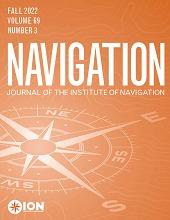Research ArticleOriginal Article
Open Access
Developing a Spoofer Error Envelope for Tracking GNSS Signals
Tobias Bamberg, Andriy Konovaltsev, and Michael Meurer
NAVIGATION: Journal of the Institute of Navigation September 2022, 69 (3) navi.534; DOI: https://doi.org/10.33012/navi.534
Tobias Bamberg
1 Institute of Communications and Navigation, German Aerospace Center (DLR), Oberpfaffenhofen, Germany
2 Chair of Navigation, RWTH Aachen University, Aachen, Germany
Andriy Konovaltsev,
1 Institute of Communications and Navigation, German Aerospace Center (DLR), Oberpfaffenhofen, Germany
Michael Meurer
1 Institute of Communications and Navigation, German Aerospace Center (DLR), Oberpfaffenhofen, Germany
2 Chair of Navigation, RWTH Aachen University, Aachen, Germany

REFERENCES
- ↵
- Akos, D. M.
- ↵
- Bamberg, T.,
- Appel, M. M., &
- Meurer, M.
- ↵
- Braasch, M. S.
- ↵
- Braasch, M. S.
- ↵
- Fernández-Hernández, I.,
- Walter, T.,
- Alexander, K.,
- Clark, B.,
- Châtre, E.,
- Hegarty, C.,
- Appel, M., &
- Meurer, M.
- ↵
- Günther, C.
- ↵
- Humphreys, T. E.,
- Ledvina, B. M.,
- Psiaki, M. L.,
- O’Hanlon, B. W., &
- Kintner Jr, P. M.
- ↵
- Irsigler, M.,
- Hein, G. W., &
- Eissfeller, B.
- ↵
- Kaplan, E. D., &
- Hegarty, C. J.
- ↵
- Kelly, J. M.,
- Braasch, M. S., &
- DiBenedetto, M. F.
- ↵
- Presti, L. L., &
- Motella, B.
- ↵
- RTCA SC-159
- ↵
- Teunissen, P. J. G., &
- Montenbruck, O.
- ↵
- Van Nee, R. D. J.
- ↵
- Van Nee, R. D. J.
In this issue
NAVIGATION: Journal of the Institute of Navigation
Vol. 69, Issue 3
Fall 2022
Developing a Spoofer Error Envelope for Tracking GNSS Signals
Tobias Bamberg, Andriy Konovaltsev,, Michael Meurer
NAVIGATION: Journal of the Institute of Navigation Sep 2022, 69 (3) navi.534; DOI: 10.33012/navi.534
Jump to section
- Article
- Abstract
- 1 INTRODUCTION
- 2 SCENARIO DEFINITION AND ASSUMPTIONS
- 3 SIGNAL TRACKING AND THE MULTIPATH ERROR ENVELOPE
- 4 CONSIDERATIONS RELEVANT FOR DERIVING THE SPOOFER ERROR ENVELOPE
- 5 SPOOFER ERROR ENVELOPE
- 6 EFFECT OF A RELATIVE DOPPLER ON THE SPOOFER ERROR ENVELOPE
- 7 GENERALIZED TRACKING BOUND
- 8 DISCUSSION OF THE APPLICATION OF INTRODUCED BOUNDS
- 9 CONCLUSION
- HOW TO CITE THIS ARTICLE
- A PROOF OF BOUNDS
- B CHARACTERISTICS OF THE IN-PHASE AND COUNTER-PHASE REGARDING TRACKING BIAS
- REFERENCES
- Figures & Data
- Supplemental
- References
- Info & Metrics
Related Articles
Cited By...
- No citing articles found.






